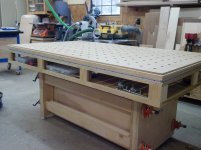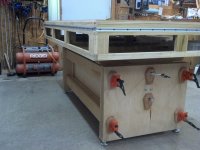Tom:
I want to qualify my level of competency, so that you (and others) can evaluate my post here. I'm a hobiest. I've got enough training on electrical to be competent. Concerning wood, I've got enough understanding to know what I want to accomplish and what is feasible without necessarily having the tools or the experience to implement what I have in mind. Getting there, but it's a process.

Context: I'm teetering on 50, with a background in critical systems software, and enjoying a hobby where screwups are measured in dollars rather than lives lost. The piper is definitely easier to pay, but I remain inclined to expect perfection.
I'm returning to wood construction seriously after a long hiatus, having never really cemented basic skills. My current table frame is the third attempt. The original design called for all-thread and metal pegs - I'm sure you've seen similar starter work table designs. The grooves for the all-thread are simple to anyone who uses a router regularly, but (until recently) I haven't used a router often enough to remember the obvious guidelines. In the course of the current project I have re-acquired a bunch of skills I used to know but had not retained. The third set is near-perfect. The first and second not so much. On the first attempt I messed up the all-thread grooves hopelessly. On the second I re-discovered how hard it is to position holes repeatably without a drill press. On the third I used the Festool Domino. I can't say that this improved my skills any. I
can say that the Domino is more repeatable in the hands of a relative novice than a lot of other tools are. Taken overall, I'd say that Festool dust extraction was a significant improvement over my Bosch router table. That's an especially significant improvement for a novice, because visual confirmation is all I have.

From the perspective of a novice I'd say that the Domino has been the most game-changing Festool device. I have a circular saw, I know how to measure, and I have a straight-edge. The track saw is more repeatable, but it isn't world-changing when you are trying to cut four stretchers. Similarly, I have a good Bosch router. The OF-1400 standing alone is definitely not an improvement (in fact, it's a downgrade), but combining it with the track and the dust extraction is a qualitative improvement. In both cases I've purchased the corresponding Festool device, and I mostly anticipate selling off the predecessors, but the fundamental benefit wasn't immediately obvious to me as a novice. I'm trained as a systems engineer, and I
do appreciate systems engineering, and I can see the advances that Festool has done. But there's a different between "this is better" and "this is qualitatively improved."
For me, the Domino stands out as filling a previously un-filled niche (for the novice), and offers repeatability that the novice cannot otherwise achieve. I'm sure that each customer has their own story for what the turning point was. That was mine. I unpacked the Domino, spent 20 minutes on the manual and on-line how-to's, and then did 96 mortises in 32 minutes. Ignoring one where my hands drifted through user stupidity, the rest were within 1mm of intended location. That seems pretty good for 96 mortises within 62 minutes out of the box. For me, that's game changing. The secret of Festool isn't the precision. It's the repeatability. The two are related, but not the same.
My original design called for the MDF lip and metal dowels/pegs to connect stretchers with legs. The lip was me modifying the pre-existing design in a way that exceeded my experience. I think I could do it now, but at the time it fell under the heading of "make a well-intentioned change so you know it's yours." The pegs are flatly unrealistic unless you have (a) a drill press, or (b) some form of drill guide (Gator or friends). Most importantly, both pegs and teñons fail if you don't have square legs.
About square legs...
I made an early decision that 2x2's were inadequate for an initial work table. This was a mistake. They
are inadequate, but 4x4s in the U.S. involve a different grade of lumber that is not dimensionally accurate. You can't reduce a 3.5"x3.5" post with a 10" table saw without a planer (cut depth insufficient). The TS-55 cut depth isn't adequate either for that particular leg. Maybe there was another (better) option that I failed to consider. The point is that I ran into a compound problem: (a) given the tools on-hand I could not cut down a 4x4 and keep it square, and (b) lacking square leg posts a whole bunch of things go wrong when you go to connect stretchers. I suppose the best way to summarize this issue is: when you lack the tools/capacity to square your lumber, it's important to buy lumber that is already square. In my local area, 4"x4" lumber is neither square nor dimensionally accurate, so if you can't square it yourself you're fighting city hall.
This being my third attempt, and having re-acquired some skills, I can see in retrospect why the various web designs were "easy". The thing is: they rely on skills that a novice doesn't actually have. In my case, I compounded the problem by taking what I read and re-designing to avoid ankle-level stretchers. I'm not sure whether
that exceeded my initial implementation skills or whether
any of the designs would have done so. What I would say in retrospect is that the key to repeatability is fool-proofness, and very few sites seem to talk about that out loud.
Let me bring this to an orderly close. I'm suffering from novice issues coupled with new tools. In retrospect, I'd encourage a qualitatively different approach for new builders. I'm half tempted to start a woodworking blog before I forget. Give where I am now, having learned from that experience, I'm on the other end. I'm resisting changes in the interest of having a table so that I can move forward. All things considered, my investment in tools
dwarfs my investment in wood. On the whole, the cost of re-starting the table from scratch in hindsigh is noise.
I suppose what I'm trying to say is this: Whatever table you initially build, it will be obsoleted by experience and you will likely rebuild it. You won't know what you want, and you surely won't have Richard Parfitt's experience. My suggestion is to take this as a given. Build a
poor table that works, then build a table to last. With luck, you'll find that the top gets preserved and the frame gets re-done.
I'm a decent document author, and I'd actually like to capture my novice experience in an article/blog entry somewhere. If someone might suggest a vehicle for that, I'd be very greatful.
- Jonathan


